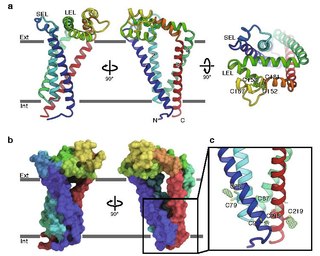
CD49d is an integrin alpha subunit. It makes up half of the α4β1 lymphocyte homing receptor.

CD9 is a gene encoding a protein that is a member of the transmembrane 4 superfamily also known as the tetraspanin family. It is a cell surface glycoprotein that consists of four transmembrane regions and has two extracellular loops that contain disulfide bonds which are conserved throughout the tetraspanin family. Also containing distinct palmitoylation sites that allows CD9 to interact with lipids and other proteins.

CD151 molecule, also known as CD151, is a human gene.

C5a anaphylatoxin chemotactic receptor 2 is a protein that in humans is encoded by the C5AR2 gene. It's a complement component G protein-coupled receptor, of class A (rhodopsin-like).

Pyroglutamylated RFamide peptide receptor also known as orexigenic neuropeptide QRFP receptor or G-protein coupled receptor 103 (GPR103) is a protein that in humans is encoded by the QRFPR gene.

CD81 molecule, also known as CD81, is a protein which in humans is encoded by the CD81 gene. It is also known as 26 kDa cell surface protein, TAPA-1, and Tetraspanin-28 (Tspan-28).

Endothelial protein C receptor (EPCR) also known as activated protein C receptor is a protein that in humans is encoded by the PROCR gene. PROCR has also recently been designated CD201.

Receptor-interacting serine/threonine-protein kinase 2 is an enzyme that in humans is encoded by the RIPK2 gene.

Guanine nucleotide exchange factor VAV2 is a protein that in humans is encoded by the VAV2 gene.

Interleukin 13 receptor, alpha 1, also known as IL13RA1 and CD213A1, is a human gene.

Macrophage-stimulating protein (MSP), also known as hepatocyte growth factor-like protein, is a protein that in humans is encoded by the MST1 gene.

Growth factor receptor-bound protein 14 is a protein that in humans is encoded by the GRB14 gene.

Neurabin-2 is a protein that in humans is encoded by the PPP1R9B gene.

Heat shock protein 75 kDa, mitochondrial is a protein that in humans is encoded by the TRAP1 gene.

Immunoglobulin superfamily member 8 is a protein that in humans is encoded by the IGSF8 gene. IGSF8 has also been designated as CD316.

G-protein-signaling modulator 1 is a protein that in humans is encoded by the GPSM1 gene.

Dual specificity protein phosphatase 22 is an enzyme that in humans is encoded by the DUSP22 gene.

Immunoglobulin superfamily, member 2 (IGSF2) also known as CD101, is a human gene.

Guanine nucleotide-binding protein subunit alpha-11 is a protein that in humans is encoded by the GNA11 gene. Together with GNAQ, it functions as a Gq alpha subunit.

Microsomal prostaglandin E synthase-1 (mPGES-1) or Prostaglandin E synthase is an enzyme that in humans is encoded by the PTGES gene.





















